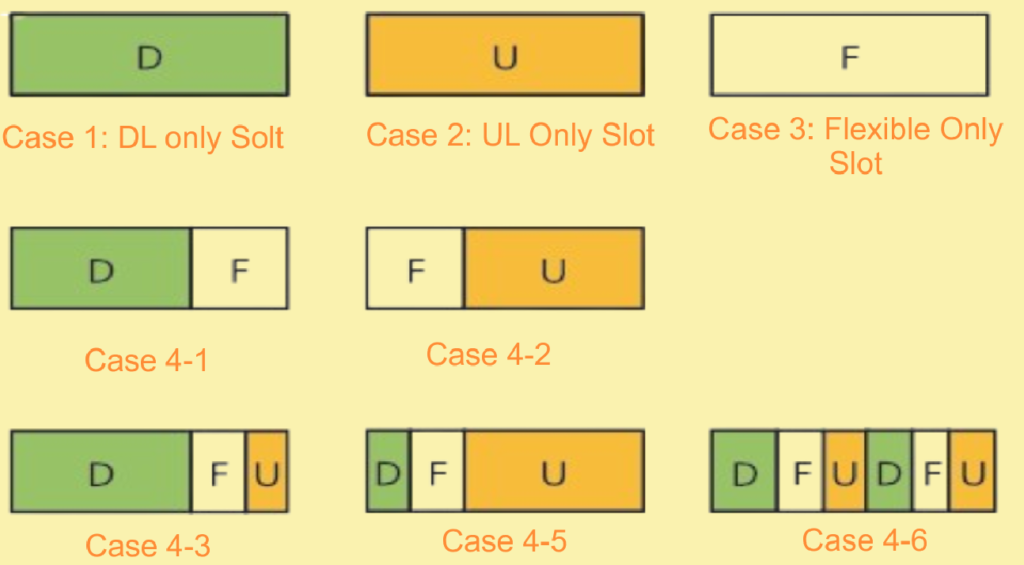In 5G New Radio (NR), OFDM symbols are classified into three types: downlink (DL), uplink (UL), and flexible (F). This classification allows for a more adaptable use of resources compared to LTE, which only supports a subframe-level switch between uplink and downlink.
Symbol 5G NR Symbol Type.
- Downlink (D): Used for downlink transmission.
- Uplink (U): Used for uplink transmission.
- Flexible (F): Can be used for either uplink or downlink transmission, can function as a guard period (GP), or can be reserved.
5G Slot Formats.
Each slot in 5G NR can consist of a combination of these symbol types. The 3GPP TS 38.213 defines various slot formats, allowing for a symbol-level switch between uplink and downlink transmissions.

The slot formats are categorized into four cases:
- Case 1: DL-only Slot
- Contains only downlink symbols.
- Case 2: UL-only Slot
- Contains only uplink symbols.
- Case 3: Flexible-only Slot
- Contains only flexible symbols.
- Case 4: Mixed Slot
- Contains at least one downlink or uplink symbol along with flexible symbols.
Mixed Slot Sub-Cases.
Case 4 is further divided into several sub-cases, offering more granular control over resource allocation. The flexibility provided by these sub-cases enhances the adaptability of 5G NR to various use cases and network conditions.
Self-contained Slots.
Self-contained slots are a specific type of mixed slot (Case 4) and are divided into:
- DL-dominant Slot (Case 4-3):
- Primarily used for downlink data transmission.
- Uplink control signals or sounding reference signals (SRSs) can be transmitted in a few symbols via time division multiplexing (TDM).
- Shortens the downlink hybrid automatic repeat request (HARQ) feedback delay.

- UL-dominant Slot (Case 4-4):
- Primarily used for uplink data transmission.
- Downlink control signals can be transmitted in a few symbols via TDM.
- Shortens the uplink scheduling delay.

In self-contained slots, a guard period (GP) is reserved between uplink and downlink transmissions to ensure proper signal transmission. No signal is transmitted or received during this period.
Mini-slot.
Mini-slots, as defined in 3GPP TR 38.802, contain fewer than 14 symbols and enable more refined time-domain resource allocation. This results in shorter scheduling delays than common slots. Mini-slots are essential for scenarios requiring low latency, such as Ultra-Reliable Low-Latency Communications (URLLC), and for unlicensed frequency band deployments where quick data transmission is critical.

Non-Slot-based Scheduling
Mini-slots facilitate Non-Slot-based scheduling, which further decreases air interface delay and allows for efficient resource allocation, particularly in the following scenarios:
- Low Latency: Essential for URLLC use cases.
- Unlicensed Frequency Band Deployment: Enables rapid data transmission when an unlicensed band becomes available.
- mmWave Band Deployment: Supports TDM for multiple UEs within a common slot.
For detailed information on the numbers of symbols for downlink and uplink Non-Slot-based scheduling, refer to sections 5.1.2 “Resource Allocation” and 6.1.2 “Resource Allocation” in 3GPP TS 38.214, respectively.
Conclusion
The classification of OFDM symbols and the diverse slot formats in 5G NR enable a flexible and efficient use of radio resources. This adaptability supports a wide range of use cases and improves the overall performance and efficiency of 5G networks. The introduction of mini-slots and Non-Slot-based scheduling further enhances the capabilities of 5G NR, making it a robust framework for next-generation wireless communications.
References
- 3GPP TS 38.300, NR and NG-RAN Overall Description; Stage 2 (Release 16)
- 3GPP TS 38.101-1, User Equipment (UE) radio transmission and reception; Part 1: Range 1 Standalone (Release 16)
- 3GPP TS 38.101-2, User Equipment (UE) radio transmission and reception; Part 1: Range 2 Standalone (Release 16).
- 3GPP TS 38.104, Base Station (BS) radio transmission and reception (Release 16).
- 3GPP TS 36.211, Physical channels and modulation (Release 14).
- 3GPP TS 38.213, Physical layer procedures for control (Release 16).
- 3GPP TS 38.211, Physical channels and modulation (Release 16).
- 3GPP TR 38.912 (Release 15).
- 3GPP TR 38.802, Physical Layer Aspects (Release 14).
Following questions are asked during interview of 5G NR RAN, RF and Microwave on topic of Time Domain Resources.
- Where do the basic time units Tc and Ts in the 5G system come from?
- What are intersymbol interference (ISI) and inter-subcarrier interference (ICI)?
- Why can extended cyclic prefixes (CPs) avoid the interference?
- What are slot formats?
- What is mini-slot?
- How do 3GPP specifications describe mini-slot?